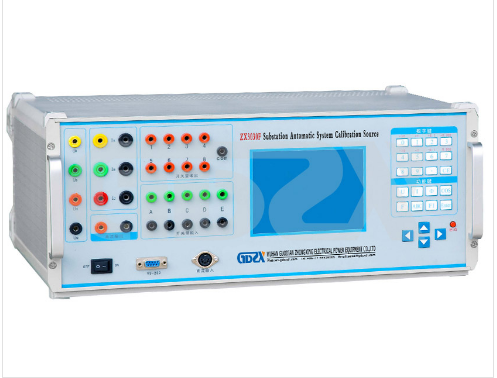NEWSnews
Advanced Testing for Substation Automation: ZX3030F vs. Traditional Methods
Substation automation systems are critical for grid reliability, requiring precise verification of their telemetry, teleindication, remote control, and remote adjustment functions – collectively known as "Four Tele" functions. The ZX3030F Substation Comprehensive Automation System Verification Apparatus, developed in collaboration with Hubei Electric Power Test & Research Institute, represents a significant leap forward in automated testing technology for these systems. This article provides a technical overview of the ZX3030F and contrasts its capabilities with traditional testing methodologies.
From Manual to Automated: A Paradigm Shift
Traditionally, testing a Remote Terminal Unit (RTU) or similar device was a time-consuming, manual process involving multiple, often disconnected, precision instruments. Technicians had to:
1.Manually set up and calibrate separate AC/DC sources for analog input tests.
2.Physically wire and trigger state changes for digital input (SOE, teleindication) tests.
3.Use separate pulse generators and counters for pulse input validation.
4.Meticulously record all data by hand, a process prone to human error.
The ZX3030F consolidates these functions into a single, integrated, and automated platform, fundamentally changing the workflow and enhancing accuracy, efficiency, and data integrity.
Core Technical Capabilities of the ZX3030F
The apparatus is built around DSP technology, GPS time synchronization, and wireless communication, enabling comprehensive automated testing.
1. Comprehensive "Four Tele" Testing:
Telemetry (Analog Input): Automates basic error measurement, response time, influence quantity tests, and scan cycle verification for AC/DC signals with a high overall system accuracy of 0.05%.
Teleindication (Status Input): Tests state consistency, Sequence of Events (SOE) resolution, and change-of-state response time.
Remote Control & Adjustment: Verifies the correct operation and output accuracy of control commands and setpoint analog outputs.
Pulse Input: Validates the accuracy of pulse counting against master station values.
2. High-Precision AC/DC Power Source:
A key component is its integrated 0.05-class precision power source. This eliminates the need for external sources and calibrators.
AC Output: Voltage (0-600V), Current (0-25A), Frequency (45-65 Hz), and Phase (0-360°) are all programmable with high resolution and accuracy.
DC Output: Provides precise DC voltage outputs (0-120% of 25V, 100V, 250V) with 0.05% accuracy.
Harmonic Output: Can output 2nd to 31st harmonics with up to 40% amplitude, allowing for power quality influence testing.
3. Digital and Pulse Simulation:
Status Output: Provides 8 independent channels with selectable voltage levels (24V-220V), simulating field contact closures.
Pulse Output: Generates configurable pulse trains (0-5kHz) with adjustable width and level.
4. Data Management and Protocol Support:
Unlike manual logs, the ZX3030F features a powerful database platform. All test results, including device parameters, can be stored, managed, and automatically formatted into test reports. It supports key protocols like CDT (DL451-91) and Polling (DL/T 634-2002), ensuring correct communication with the master station.
Technical Comparison: ZX3030F vs. Traditional Methods
Feature | ZX3030F Apparatus | Traditional Methods |
System Integration | All-in-one system: source, measure, sequence, record. | Multiple discrete instruments (sources, meters, switches, counters). |
Test Automation | Fully automated test sequences. Manual intervention minimal. | Primarily manual operation, step-by-step. |
Data Accuracy & Recording | Automated, digital recording with 0.05% class accuracy. Eliminates transcription errors. | Manual recording on paper; prone to human error. |
SOE Resolution Testing | Automated using integrated GPS timing and status source. Highly accurate and repeatable. | Complex setup with multiple synchronized state stimulators and recorders. |
Report Generation | Automatic generation of standardized test reports and raw data logs from the database. | Manual compilation and typing of reports from handwritten notes. |
Workflow Efficiency | High. Setup once, run comprehensive tests. Drastically reduces man-hours per device. | Low. Repeated setup and teardown for different tests. Time-consuming. |
Harmonic Testing | Integrated 2-31st harmonic output. | Requires an external, expensive harmonic generator. |
Conclusion:
The ZX3030F Substation Automation System Verification Apparatus is not merely an instrument but a complete testing solution. It addresses the limitations of traditional manual testing by providing a unified, automated, and highly accurate platform. For technical personnel, mastering this device means moving from a repetitive, error-prone process to a highly efficient, data-driven workflow. Its ability to automatically execute complex test sequences, manage data, and generate reports ensures thorough validation of protection and control systems in line with modern smart grid requirements, ultimately enhancing the reliability and safety of power system operations.
GDZX is a manufacturer of power detection equipment, offering a diverse range of products with comprehensive models and providing professional technical support. Contact us at +86-27-6552607 or +86-17396104357.Website: http://en.gdzxdl.com/






















